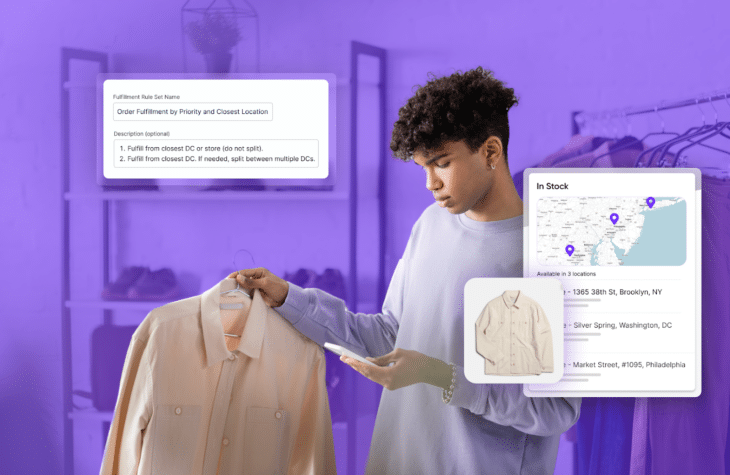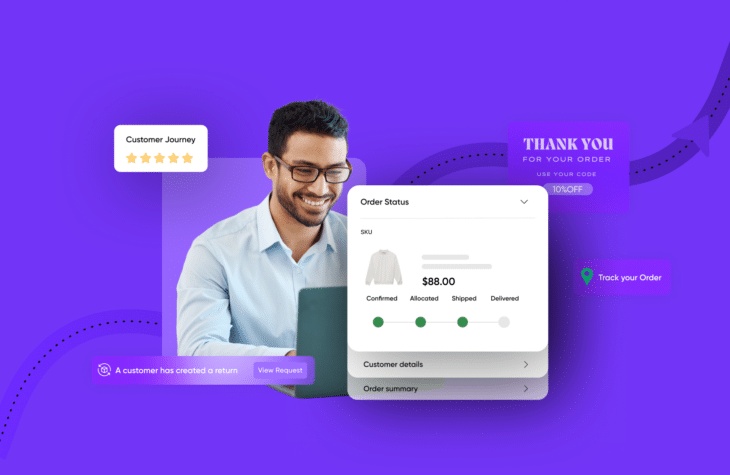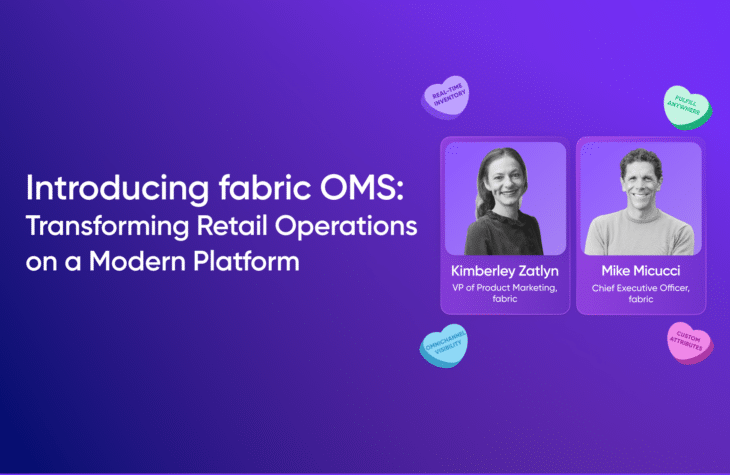What Is Distributed Order Management (DOM)? The Enterprise Guide
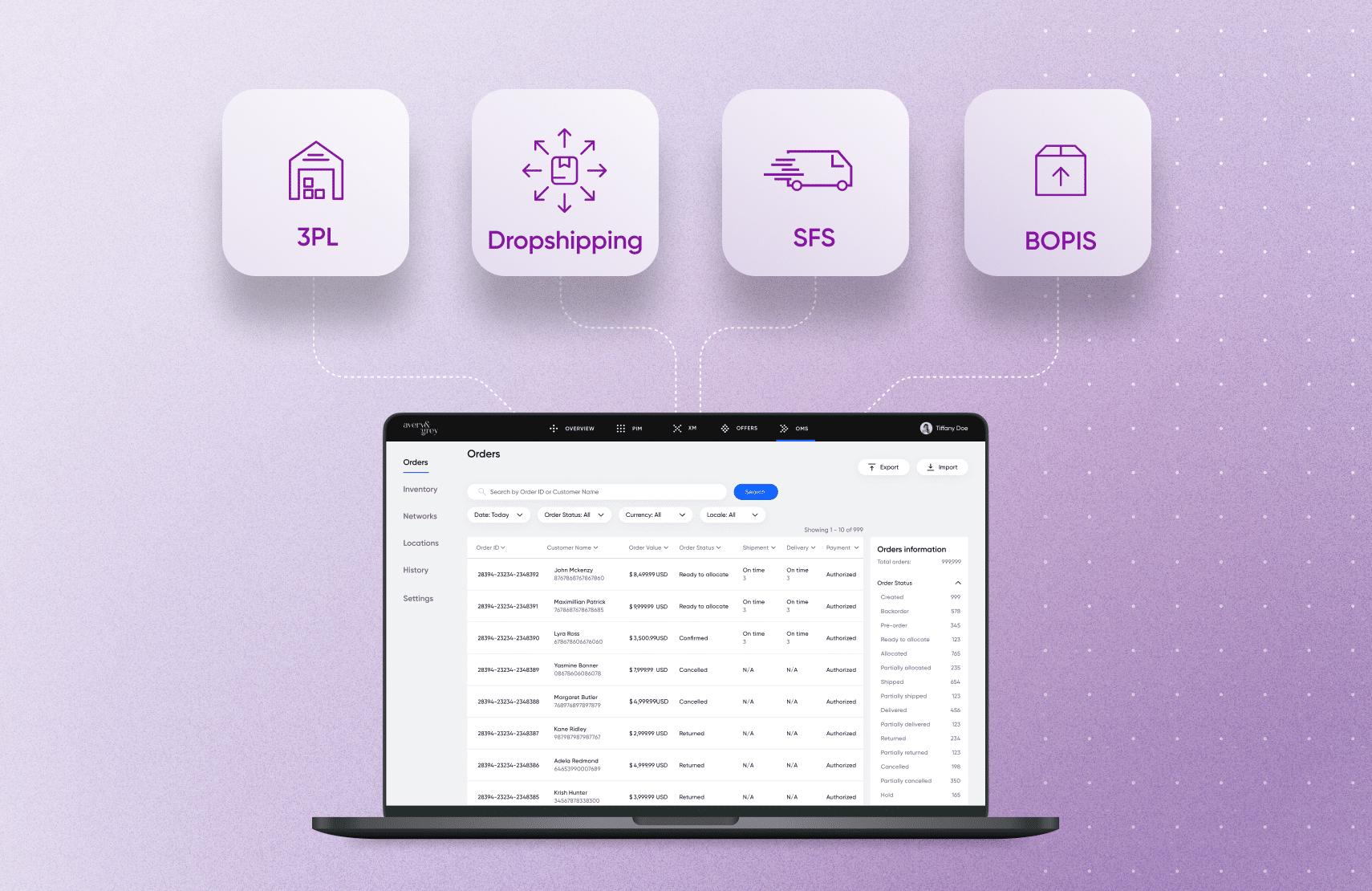
What Is A Distributed Order Management System?
A distributed order management (DOM) system is order management software that utilizes order fulfillment logic (OFL), or logic-based rules, to orchestrate and optimize the order fulfillment process. It seeks to minimize fulfillment lead times and maximize customer satisfaction but at the lowest possible cost to the retailer. DOM systems streamline order management processes through automation, order routing, and omnichannel order fulfillment.
Overview
A quick scan across the global retail landscape will reveal that distributed order management (DOM) may be the biggest innovation in order management that most companies are unaware of.
Indeed, in the race to provide faster fulfillment and better shopping experiences to customers, many mid-market and enterprise retailers are missing the opportunity to improve their order fulfillment operations with modern software that shortens the click-to-customer cycle.
How much does speed matter?
According to research by management consulting firm McKinsey:
- When delivery times are too long, almost half (46%) of omnichannel consumers will shop elsewhere.
- More than 90% of US online shoppers expect free two- to three-day shipping as a baseline for deliveries, and 30% expect same-day delivery.
- More than 75% of the specialty retail supply chain leaders have made 2-day delivery a priority, and 42% are aiming to offer same-day delivery by this year (2022).
- U.S. consumers largely remain unwilling to pay for speed. Only 20% of U.S. consumers will accept a marginal increase in shipping fees for faster shipping than standard free-delivery options.
Furthermore, McKinsey also found that while e-commerce is set to exceed 20% of retail sales, current fulfillment networks are only built to handle half that volume. Faced with the rapidly rising costs of omnichannel order fulfillment, firms are simply not meeting the challenges of improving delivery speeds in a sustainable and profitable way. Below are a few examples of what US customers value in omnichannel retail:
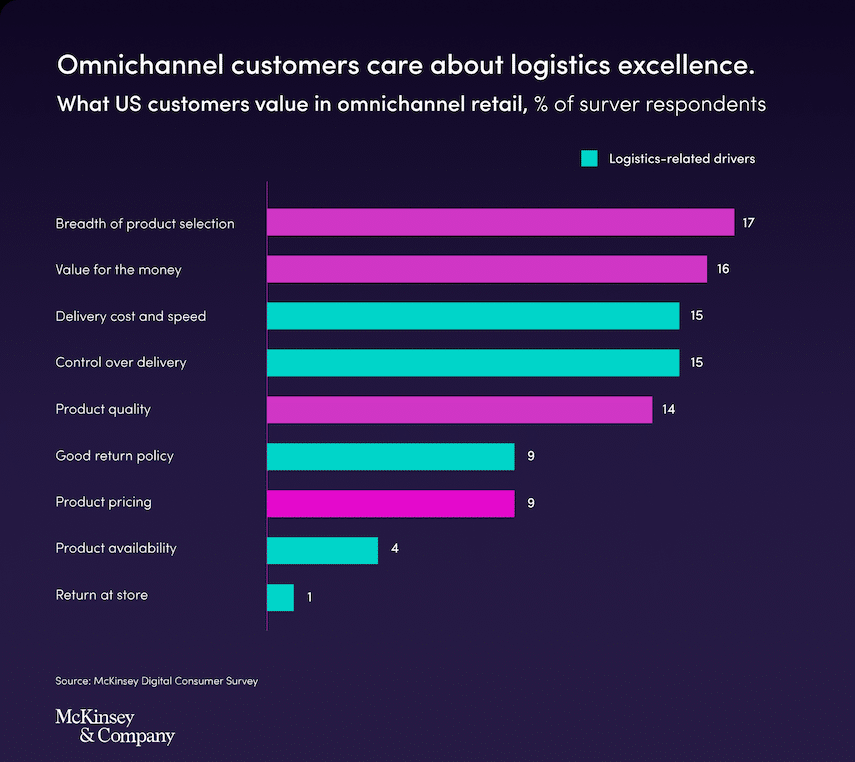
Clearly, logistics-related drivers like delivery cost and speed, control over delivery, return policies, product availability, and the option to return products to stores are top of mind for today’s discerning consumers. In response, omnichannel retailers and brands are beginning to turn to DOM systems to meet rising customer expectations and optimize order fulfillment efficiency, lower costs, boost profit margins, and meet service-level requirements.
In this complete guide on distributed order management, we’ll discuss everything you need to know about DOM systems, including:
- What they are
- How they work
- Who uses them
- How they compare to traditional order management systems (OMS)
- And what benefits they can offer to omnichannel retailers
We’ll also explore the most critical features to look for when considering a DOM system, and we’ll provide some details on how switching to a modern OMS with DOM capabilities can potentially pay for itself. Let’s begin!
DOM 101: What is Distributed Order Management (DOM) in E-Commerce?
Distributed order management in e-commerce orchestrates and optimizes omnichannel order fulfillment for retailers and brands. Here’s how technology research and consulting firm Gartner defines retail DOM:
Retail Distributed Order Management (DOM) systems use rule-based procedures to determine how best to fulfill customer orders — a key consideration for balancing both fulfillment lead times and retailer’s costs. The purpose of a DOM application is to allow retailers and consumer product (CP) companies to maximize order fulfillment while balancing two constraints: the customer expects their order to be fulfilled on time and in full and the company wishes to meet these customer expectations but at the lowest possible cost of order fulfillment. The DOM, therefore, looks to orchestrate and optimize the process of customer order fulfillment by managing these constraints and without having to trade off one over the other.
To gain a better understanding of DOM in e-commerce, let’s learn several key terms that relate to the distributed order management function.
Available-to-promise (ATP)
ATP refers to the projected amount of inventory a business has in stock that’s ready to sell and not allocated for existing customer orders. ATP helps businesses keep enough inventory available to sell and anticipates future requirements using data-based forecasts. Pre-orders can allow retailers to sell items before they are ATP and release them on the specified pre-order release date that they become ATP.
Order routing
Order routing determines the optimal fulfillment locations to ship orders from and routes customer orders based on predefined business rules. These rules, otherwise known as order fulfillment logic (OFL), are used to intelligently optimize order fulfillment within the retail supply chain.
Omnichannel order fulfillment
Omnichannel order fulfillment, or omnichannel fulfillment, occurs when businesses use multiple channels to fulfill customer orders, regardless of where the orders are placed from. Omnichannel fulfillment can take place in warehouses, fulfillment centers, stores, and other locations, including third-party logistics providers (3PLs), and helps to get products into the hands of consumers in the fastest and most efficient way possible.
Omnichannel e-commerce

Omnichannel e-commerce, or omnichannel commerce, is a sales approach that provides customers with a unified and seamless shopping experience across multiple sales channels, such as websites, mobile apps, marketplaces, social channels, and brick-and-mortar stores.
Who Uses DOM?
In the order management field, DOM was born out of necessity.
For simple business operations that fulfill orders from a single channel, a traditional order management system (OMS) is generally the primary choice. These systems are purpose-built to simplify and streamline key order management functions, including inventory management, order intake, order processing, fulfillment, and post-transaction management.
However, businesses that scale in size generally have more complex retail operations. For example, some companies have a growing number of product suppliers as they expand their product assortment.
Omnichannel order fulfillment means that orders can come from distribution centers, stores, a marketplace where multiple vendors sell the product, or they can be dropshipped by vendors. In addition to many sales channels and large and complex fulfillment requirements, these companies also need to manage inventory across their entire retail sales network, which requires a single source of truth and a 360-degree view of orders in every stage of the order lifecycle.
Whether products need to be shipped from a single or multiple warehouses, fulfillment centers, stores, or other locations, a DOM system offers these businesses a way to dramatically simplify their omnichannel inventory and order management functions to get the right products to the right customers in the fastest and cheapest way possible.
Why is a DOM system important for omnichannel retail operations?
Simply put, shoppers are not happy with the online shopping experience today. According to the national American Customer Satisfaction Index (ACSI), customer satisfaction for internet retail in 2020-2021 fell more than any other retail sector in the U.S., dropping 3.7%.
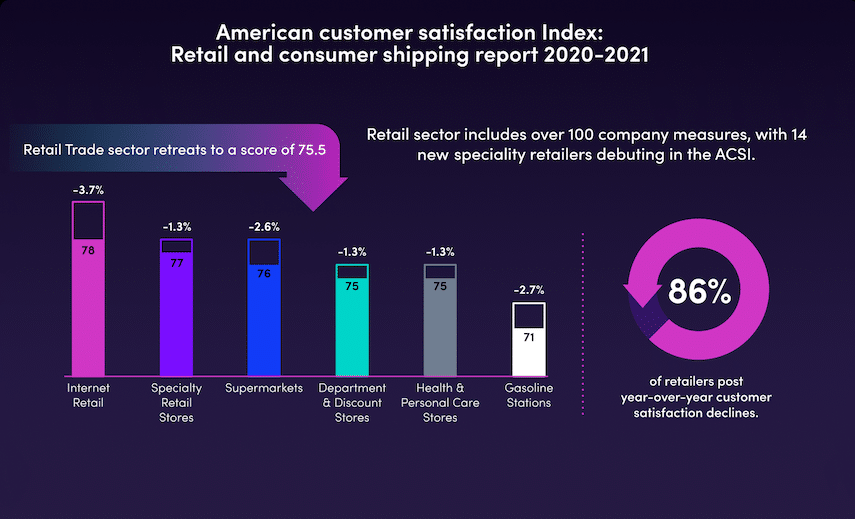
Today, overall customer satisfaction in the U.S. has declined to its lowest level in 17 years. With global e-commerce sales projected to reach $5.542 trillion this year and soar to $7.391 trillion by 2025, businesses that want to succeed in e-commerce need to cope with rapid changes in consumption, channel shifts, and rising customer expectations around speed and convenience.

A key step to addressing these concerns is orchestrating and optimizing omnichannel fulfillment to deliver best-in-class fulfillment experiences to customers. Today’s businesses require more powerful capabilities, including the ability to leverage stock across multiple locations, provide a seamless shopping experience across channels, reduce shipping costs, optimize inventory levels, reduce overstock, and boost inventory velocity.
How Do DOM Systems Work?
The core idea behind DOM systems is that orders should be fulfilled from the most optimized location that has the item the customer is ordering. It offers the flexibility to adapt to changes or issues with orders, demand, and supplier availability.
In a modern supply network, distributed order management needs to be capable of:
- Managing orders placed on a variety of platforms or channels
- Managing returns efficiently in a cost-effective manner
- Monitoring inventory across all channels, including the visibility of inventory levels across the supply chain, multiple storage facilities, and interoperability across vendors in the supply chain
- Organizing order fulfillment across channels to enhance delivery schedules, delivery route optimization, and more
Order fulfillment logic (OFL) is key for omnichannel retailers because it can set business constraints and objectives for operations to follow. For example, to maximize order fulfillment and find the correct sources for product delivery, OFL can minimize costs by setting rules to fulfill orders from the closest sources. A DOM system would factor in:
- Distances between shipping destinations and sources
- Costs that would fall within a company’s business objectives
- Certain business rules or constraints, such as only using inventory at fulfillment nodes
The following illustration shows a modern OMS model with DOM capabilities.
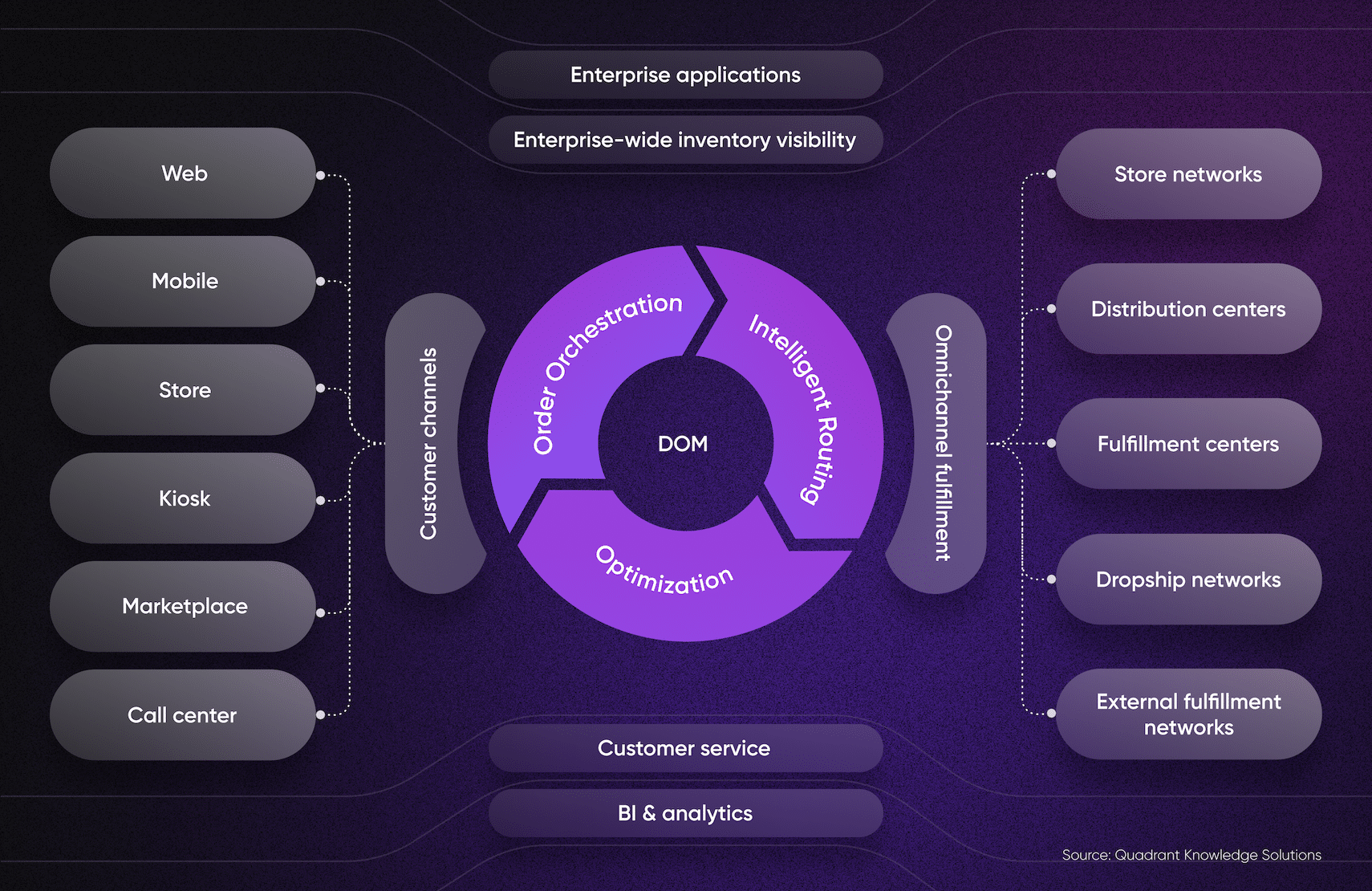
Traditional OMS vs Distributed Order Management (DOM) System
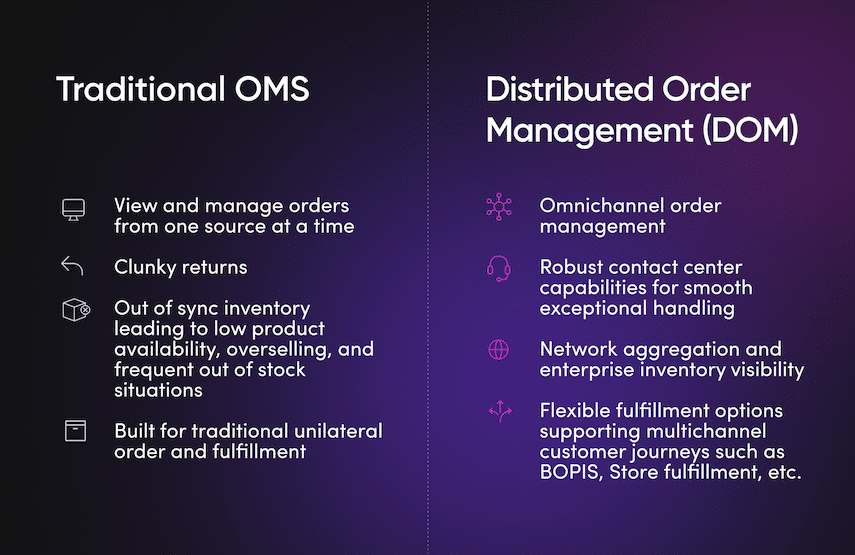
Traditional OMS
Simple retail operations will generally employ a traditional OMS application. Companies that sell through a single sales channel and use one fulfillment location will benefit from using a traditional OMS to help streamline order management. In addition to simplifying the order management process, which consists of several steps including order intake, order processing, and post-transaction management, retailers can view and manage orders from one source at a time with software that’s built for traditional unilateral order and fulfillment.
However, where traditional applications fall short is omnichannel retail. For example, initiating returns and exchanges can often be clunky and difficult to complete without a streamlined capability of handling items returned to a store. Instead, customers need to contact the retailer, receive a shipping label, repackage the item, and bring it to a designated location to have the item shipped back to the retailer.
With less robust solutions, inventory can become out of sync across a large and growing modern supply network as well. Retailers with suboptimal software that’s limited to a fixed fulfillment center can often face low product availability, overselling, and frequent out-of-stock situations—conditions that would lead to higher bounce rates and dissatisfied customers. Businesses that outgrow the capabilities of a traditional OMS require more robust capabilities, which a DOM system provides.
DOM System
A DOM system does everything a traditional OMS does and more. An order management system built with DOM capabilities can provide network aggregation with enterprise inventory visibility across all stores, fulfillment centers, and distribution centers seamlessly. The enhanced inventory visibility and accuracy not only allows a company to be fully transparent about available-to-promise (ATP) inventory to match customer expectations, but it also allows them to optimize omnichannel order fulfillment using OFL.
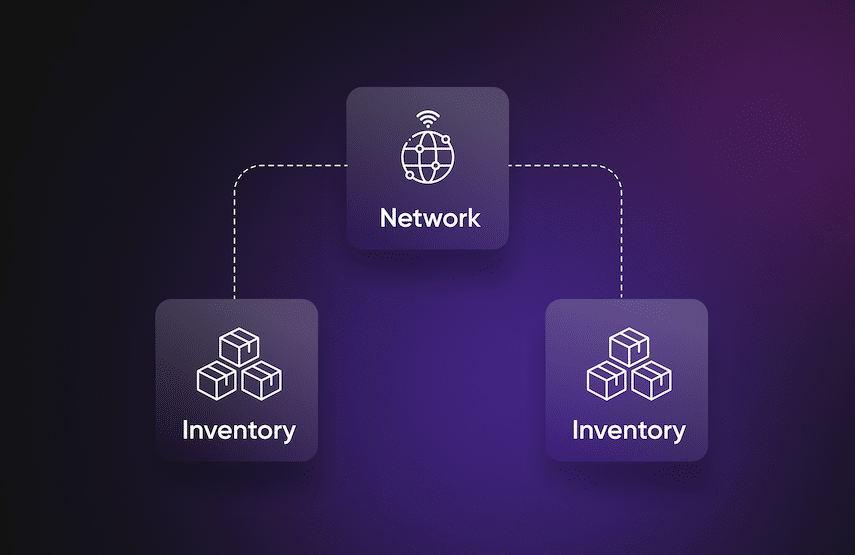
Advanced order-routing and logic-based rules can simplify the fulfillment process by determining the optimal fulfillment locations to ship orders from. For example, a customer could purchase multiple items to furnish a living room, and a DOM system might process each line item and aggregate the inventory from different fulfillment locations to deliver all the items to the customer at the same time.
Additionally, DOM supports retailers with larger fulfillment networks and more sales channels and can handle complex fulfillment operations, including multi-channel customer journeys such as buy-online-pickup-in-store (BOPIS), ship-from-store, ship-to-store, return-to-store, and more. It can also offer robust contact center support and preorder/backorder capabilities.
Preorders can help a business build hype, anticipate demand, and adjust inventory levels accordingly. Backorder capabilities allow the company to still have ATP inventory for a later date, even if the stock runs out across the network. Furthermore, unbound inventory means that even if an item is out of stock in a store, the business can still capture the order by using an iPad or kiosk in-store to access inventory within the network and fulfill it from a different location. These features make it much more difficult for businesses to run out of inventory.
To summarize, a DOM system is designed to orchestrate and enable cross-channel commerce. It optimizes the process of omnichannel order fulfillment for the customer while also aiming for the lowest possible cost to fulfill that order for the retailer.
Key Features To Look For in a DOM System
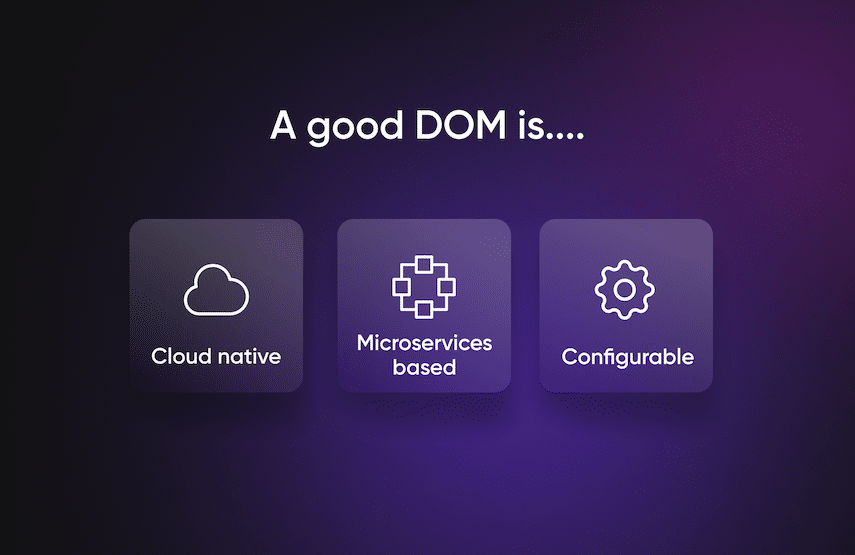
Before the rise of DOM, omnichannel retailers were essentially forced to develop their own distributed order management capabilities in-house to perform the functions needed for their specific businesses. Because there were no suitable solutions available in the market, companies constantly faced complicated and expensive coding and customization hurdles.
Today, we live in an era where software-as-a-service (SaaS) vendors have developed order management applications with advanced DOM capabilities built into their systems, giving retailers full access to many powerful features and functions straight out of the box. But what should companies actually look for in a DOM application today?
Ease of integration
Perhaps the most important thing to consider is how to integrate distributed order management into existing applications and experiences. The flexibility and scalability of having a microservices-based architecture, using APIs to communicate between applications, allows companies to mix and match many services to build their use cases appropriately.
Ease of integration with an existing tech stack is a key consideration for a DOM system. It should easily work with a company’s warehouse management system (WMS), enterprise resource planning (ERP) system, and accounting system, to name a few.
High availability
Website slowdowns, crashes, and outages happen all the time—especially during peak shopping seasons—which leads to tremendous losses for online retailers. Therefore, another important consideration for a DOM application is high availability.
For example, the worst thing that can happen on Black Friday or Cyber Monday is for a network to go down just when traffic and sales volume are running at elevated levels. Retailers also never want to run out of inventory during these critical times or they’ll risk losing sales when it matters most. A cloud-native application with multi-region cloud availability allows companies to fulfill orders seamlessly and keep the customer experience consistent—even during peak times.
Configurability
There is no such thing as a one-size-fits-all order management software solution. Every business is different and has their own complex unique use cases they need to solve.
Therefore, the ability to use configuration rather than code to customize software to suit a company’s individual needs is crucial. It can allow business operators with little to no coding expertise to configure rule-based logic to set, schedule, and normalize rules for network optimization. Configuration would also free up developer resources to focus on building differentiating experiences and improving customer service.
7 Key Benefits of Switching to a DOM System
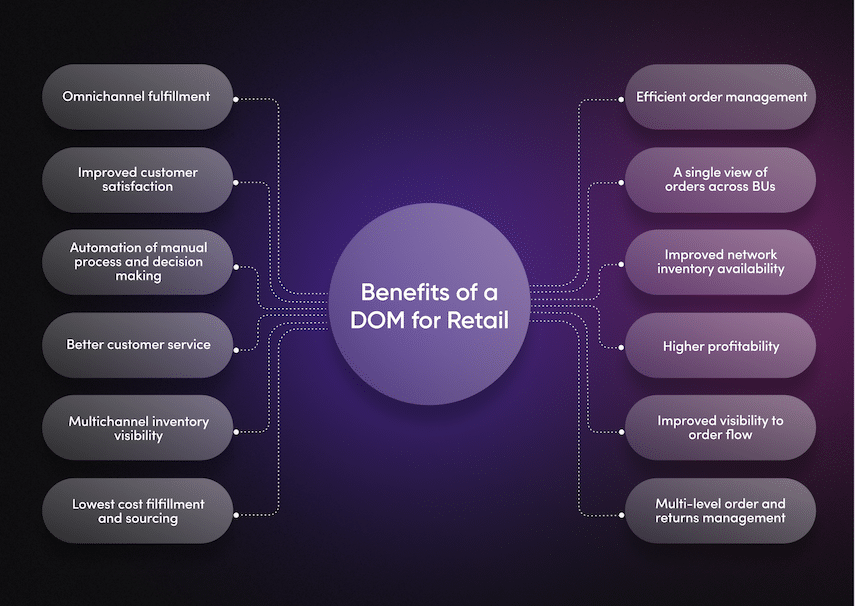
To meet rising consumer expectations around speed and convenience, businesses require fast, flexible, and reliable software with enterprise-grade scalability to optimize omnichannel order management and fulfillment. Companies that are ready to scrap their manual systems in favor of advanced DOM software, or are ready to switch from a traditional OMS to a modern system with DOM capabilities, can enjoy several key benefits.
1. Multichannel inventory and order visibility
A DOM provides a near real-time, 360-degree view of customer purchases as well as on-shelf, in-transit, and on-order inventory at distribution centers, stores, and suppliers.
2. Optimized order management and omnichannel fulfillment
Retailers can easily track and manage orders from order placement to post-delivery services. They can also use OFL to manage complex order fulfillment logic to get the right products to the right customers in the quickest and most cost-effective way possible.
3. Automation of manual processes and decision making

A DOM excels at eliminating tedious and error-prone manual processes. It can remove spreadsheets from the order management function and automate important tasks like tracking and syncing orders across the supply network.
4. Lowest cost fulfillment and sourcing
In an inflationary environment where costs are rising, and margins are deteriorating, it’s important for companies to squeeze out efficiencies wherever possible. OFL can be utilized to determine the most cost-efficient way to source and fulfill orders based on distance, carrier service levels, and more.
5. Improved network inventory availability
Greater and more accurate visibility into inventory across the network helps to improve inventory availability, minimize stockouts, and reduce the overselling of items.
6. Multi-level order and returns management
Not only can a DOM application provide customers with easy returns and exchanges and automated refund processes, it can also simplify reverse logistics by setting business rules for accepting and processing returns and exchanges.
7. Improved customer service
The ultimate goal for any retailer should be to improve the overall customer experience. In addition to using DOM to implement ATP processes to match customer expectations, companies can optimize the fulfillment experience to get products in the hands of customers in the fastest and most efficient way possible.
How Much Does DOM Cost? Implementing a DOM System Can Pay For Itself
Any mid-market and enterprise brand with omnichannel fulfillment requirements should consider an OMS with advanced distributed order management capabilities. But how much does the software cost?
The answer depends on the size and complexity of a company’s retail operations. For example, SaaS vendors follow a service-based model and offer elasticity in the pricing based on the demand. In other words, the number of fulfillment locations and the total volume of orders can impact the cost of a software solution.
However, the most important thing to note is that modern OMS software with DOM capabilities is generally cheaper than most legacy software vendors.
For example, legacy OMS providers that offer robust feature sets will charge exorbitant prices for even the simplest upgrades and enhancements. By completing a total cost of ownership (TCO) analysis, businesses can gain a clear understanding of what it costs to run their legacy systems. Once a business accounts for software licensing, hosting and maintenance, payment processing, software development, site operations, and professional services, plus additional hidden costs, they’ll likely find that they’re paying an “e-commerce tax” of roughly 8% to 15% on the gross merchandise volume (GMV) they generate.
However, fabric OMS is a powerful solution that offers DOM capabilities and advanced order routing at a fraction of the cost of legacy OMS applications. Not only does it provide retailers with the latest and most powerful features and capabilities straight out of the box, but it also saves money by introducing cost savings across the board.
This hypothetical scenario outlines how fabric’s OMS and platform help one company achieve TCO savings of $27.7 million on $500 million in GMV. Costs immediately drop 59% from $46.8 million to $19.1 million when a business drops its legacy OMS and commerce platform.
By slashing the “e-commerce tax,” companies can use the massive cost savings to switch to a modern OMS and still have ample funds left over to boost their bottom lines. Furthermore, retailers can enjoy a short payback period, which helps to increase margins and improve profitability faster than most companies expect.
fabric OMS is an API-first, cloud-native, and modular application that features DOM and advanced order routing for maximum efficiency, speed, scale, and flexibility. If you want to learn more about its powerful features and capabilities or about how switching to our OMS can essentially pay for itself, feel free to get in touch with us today.

Platform solutions @ fabric. Previously advising @ Sedai, Arrivy, and Instant Labs Inc.


